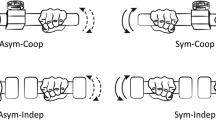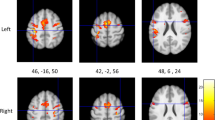Abstract
We used functional magnetic resonance imagery (fMRI) to study cortical activation during index finger–thumb opposition of both hands using in-phase and out-of-phase modes. In-phase movements activated the sensorimotor cortex. During out-of-phase movements, activations were also observed in the supplementary motor area (SMA), in the cingulate motor area (CMA) and, less frequently, in the anterior cingulate cortex (ACC). As we have previously shown and confirmed in the present study, the same out-of-phase bimanual movements specifically activate the cerebellar second homunculus, leading us to postulate that the cerebellar second homunculus and medial wall motor areas participate in a circuit specifically involved in timing complex movements.



Similar content being viewed by others
References
Ellerman JM, Flament D, Kim SG, Fu QG, Merkle H, Ebner TJ, Ugurbil K (1994) Spatial patterns of functional activation of the cerebellum investigated using high field (4T) MRI. NMR Biomed 7:63–68
Grodd W, Hulsmann E, Lotze M, Wildgruber D, Erb M (2001) Sensorimotor mapping of the human cerebellum: fMRI evidence of somatotopic organization. Hum Brain Mapp 13:55–73
Nitschke MF, Kleinschmidt A, Wessel K, Frahm J (1996) Somatotopic motor representation in the human cerebellum. A high-resolution functional MRI study. Brain 119:1023–1029
Rijntjes M, Buechel C, Kiebel S, Weiller C (1999) Multiple somatotopic representation in the human cerebellum. Neuroreport 10:3653–3658
Habas C, Axelrad H, Nguyen TH, Cabanis EA (2004) Specific neocerebellar activation during out-of-phase bimanual movements. Neuroreport 15:595–599
Habas C, Axelrad H, Cabanis EA (2004) The cerebellar second homunculus remains silent during passive bimanual movements. Neuroreport 15:1571–1574
Schmahmann JD, Pandya DN (1997) The cerebrocerebellar system. Int Rev Neurobiol 41:31–60
Middleton FA, Strick PL (2000) Basal ganglia and cerebellar loops: motor active and cognitive circuits. Brain Res Rev 31:236–250
Picard N, Strick PL (1996) Motor areas of the medial wall: a review of their location and functional activation. Cereb Cortex 6:342–353
Immisch I, Waldvogel D, van Gelderen P, Hallett M (2001) The role of the medial wall and its anatomical variations for bimanual antiphase and in-phase movements. Neuroimage 14:674–684
Jantzen KJ, Steinberg FL, Kelso JA (2004) Brain networks underlying human timing behavior are influenced by prior context. Proc Natl Acad Sci U S A 17:6815–6820
Nair DG, Purcott KL, Fuchs A, Steinberg F, Kelso JAS (2003) Cortical and cerebellar activity during imagined and executed unimanual and bimanual action sequences: a functional MRI study. Brain Res Cogn Brain Res 3:250–260
Stephan KM, Binkofski F, Halsband U, Dohle C, Wunderlich G, et al (1999) The role of the ventral wall motor areas in bimanual co-ordination. A combined lesion and activation study. Brain 122:351–368
Dhamala M, Pagnoni G, Wiesenfeld K, Zink CF, Martin M, Berns GS (2003) Neural correlates of the complexity of rhythmic finger tapping. Neuroimage 20:918–926
Deiber MP, Honda M, Ibanez V, Sadato N, Hallett M (1999) Mesial motor areas in self-initiated versus externally triggered movements examined with fMRI: effect movements type and rate. J Neurophysiol 81:3065–3077
Dettmers C, Fink GR, Lemon RN, Stephan KM, Passingham RE, et al (1995) Relation between cerebral activity and force in the motor areas of the human brain. J Neurophysiol 74:802–815
Seitz RJ, Stephan KM, Binkovski F (2000) Control of action as mediated by the human frontal lobe. Experimental Brain Research 133:71–80
Wiese H, Stude P, Nebel K, de Greiff A, Forsting M, et al (2004) Movement preparation in self-initiated versus externally triggered movements: an event-related fMRI-study. Neurosci Lett 371:220–225
Haslinger B, Erhard P, Altenmuller E, Hennenlotter A, Schwaiger M, et al (2004) Reduced recruitment of motor association areas during bimanual coordination in concert pianists. Hum Brain Mapp 22:206–215
Pardo JV, Fox PT, Raichle ME (1991) Localization of a human system for sustained attention by positron emission tomography. Nature 349:61–64
Sadato N, Yonekura Y, Waki A, Yamada H, Ishii Y (1997) Role of the supplementary motor area and the right premotor cortex in the coordination of bimanual finger movements. J Neurosci 15:9667–9674
Serrien DJ, Nirkko AC, Lovblad KO, Wiesendanger M (2001) damage to the parietal lobe impairs bimanual coordination. Neuroreport 12:2721–2724
Jancke L, Shah NJ, Peters M (2000) Cortical activations in primary and secondary motor areas for complex bimanual movements in professional pianists. Brain Res Cogn Brain Res 10:177–183
Toyokura M, Muro I, Komiya T, Obara M (1999) Relation of bimanual coordination to activation in the sensorimotor cortex and supplementary motor area: analysis using functional magnetic resonance imaging. Brain Res Bull 48:211–217
Meyer-Lindenberg A, Ziemann U, Hajak G, Cohen L, Berman KF (2002) Transitions between dynamical states of differing stability in the human brain. Proc Natl Acad Sci U S A 99:10948–10953
Chen JT, Lin YY, Shan DE, Wu ZA, Hallett M, Liao KK (2005) Effect of transcranial magnetic stimulation on bimanual movements. J Neurophysiol 93:53–63
Debaere F, Wenderoth N, Sunaert S, van Hecke P, Swinnen SP (2004) Changes in brain activation during the acquisition of a new bimanual coordination task. Neuropsychologia 42:855–867
Palay SL, Chan-Palay V (eds) (1974) Cerebellar cortex. Cytology and organization. Springer-Verlag, Berlin Heidelberg New York
Spencer RM, Zelaznik, HN, Diedrichsen J, Ivry RB (2003) Disrupted timing of discontinuous but not continuous movements by cerebellar lesions. Science 300:1437–1439
Schaal S, Sternad D, Osu R, Kawato M (2004) Rhythmic arm movement is not discrete. Nat Neurosci 10:1136–1143
Kennerley SW, Diedrichsen J, Hazeltime E, Semjen A, Ivry RB (2002) Callosotomy patients exhibit temporal uncoupling during continuous bimanual movements. Nat Neurosci 5:376–381
Carson RG (2005) Neural pathways mediating bilateral interactions between the upper limbs. Brain Res Brain Res Rev 49:641–662
Van Mier H, Tempel LW, Perlmutter JS, Raichle ME, Petersen SE (1998) Changes in brain activity during motor learning measured with PET: effects of hand performance and practice. J Neurophysiol 80:2177–2199
Puttemans V, Wenderoth N, Swine SP (2005) Changes in brain activation during the acquisition of multifrequency bimanual coordination task: from the cognitive stage to advanced levels of automaticity. J Neurosci 25:4270–4278
Doyon J (1997) Skill learning. Int Rev Neurobiol 41:273–294
Luft AR, Skalej M, Stefanou A, Klose U, Voigt K (1998) Comparing motion- and imagery-related activation in the human cerebellum: a functional MRI study. Hum Brain Mapp 6:105–113
Temprado JJ, Monno A, Zanone PG, Kelso JA (2002) Attentional demands reflect learning-induced alterations of bimanual coordination dynamics. Eur J Neurosci 16:1390–1394
Bischoff-Grethe A, Ivry RB, Grafton FT (2002) Cerebellar involvement in response reassignment rather than attentional process. J Neurosci 22:546–553
Kelly RM, Strick PL (2003) Cerebellar loops with motor cortex and prefrontal cortex of a nonhuman primate. J Neurosci 23:8432–8444
Author information
Authors and Affiliations
Corresponding author
Rights and permissions
About this article
Cite this article
Habas, C., Cabanis, E. Cortical areas functionally linked with the cerebellar second homunculus during out-of-phase bimanual movements. Neuroradiology 48, 273–279 (2006). https://doi.org/10.1007/s00234-005-0037-0
Received:
Accepted:
Published:
Issue Date:
DOI: https://doi.org/10.1007/s00234-005-0037-0




